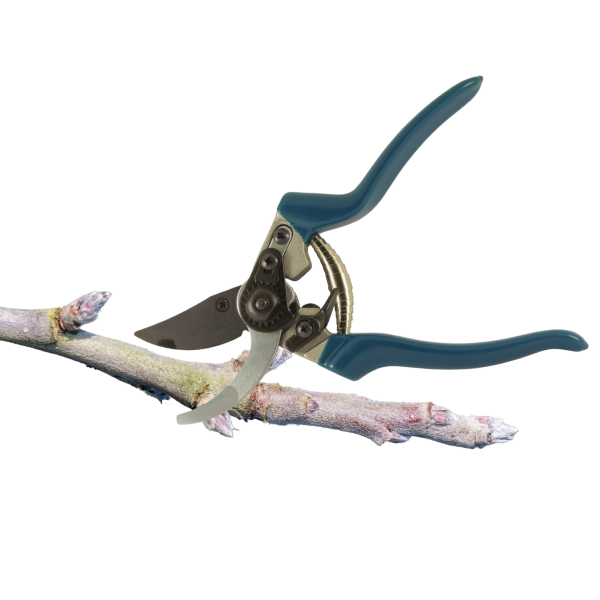Fruit Buds And Floating Apples!
Apple & Pear Pruning Prerequisite: IDENTIFYING FRUIT BUDS
Where does fruit form on a fruit tree?
Does it pop up in random places, or does each tree have an advance plan?
Knowing where your apple and pear trees are planning to produce fruit is an important first step when it comes to pruning! This knowledge will help guide your pruning cuts to protect both the branches and the harvest. It will also help you decide if the variety you are working with is suitable for the training form you have in mind.
Okay so maybe these apples aren’t really “floating” per se, but it sure looks like it from a distance! The fruiting habit of this tip bearing tree is what gives it this appearance and you will learn what that means if you read on.
STEP ONE: FIND OUT WHERE FRUIT IS BORN
To get started, you will need to learn to identify two different types of buds found on your fruit trees. It’s fairly easy, if you take the time to look!
Fruit bud
The first type of bud you will look for is the: FRUIT BUD
Fruit spur system
Simply put - fruit grows from FRUIT BUDS.
Fruit buds contain flowers that are destined to become fruit as long as they are pollinated.
They will usually be plump and develop a soft, sometimes fuzzy appearance.
Once the growing season begins, they are often surrounded by a cluster of leaves.
Over time fruit buds develop into fruit spurs, which are short knobby modified stems, and later these turn into fruit spur systems.
Vegetative buds
The next type of bud you will look for is the: VEGETATIVE BUD
Vegetative buds will develop into leaves and/or shoots.
They do not contain flowers and therefore will not bear fruit.
These buds are usually slender and pointed and lay flatter to the branch.
STEP TWO: LEARN ABOUT THE DIFFERENT TYPES OF FRUITING HABITS
Now that you know the difference between a fruit bud and a vegetative bud, it’s time to learn where on your tree, the fruiting buds are produced.
SPUR BEARING VS TIP BEARING?
Most fruit trees fall into three different categories according to where their fruiting buds are produced: Spur bearing, Tip bearing, or Partially tip bearing.
1.Spur Bearing
A developed fruit spur emerging from the side of a branch on an apple tree.
Spur-bearing trees produce fruit on short knobby looking shoots called spurs. Spurs on most fruit trees form on two year old wood and older. These spurs develop spaced out all along the main branches, and over time they develop into what we call “spur systems” containing multiple spurs. When the mature tree produces fruit, you will see fruit all along the branches coming out of these spurs. They are easy to spot once you know what you’re looking for.
2. Tip Bearing
Other trees form fruit buds only on the tips of shoots formed the previous season. This means if you are looking at your tree in the dormant season - next year’s fruit buds have already formed on the tips of these branches.
It is especially important to identify this type of fruiting habit, so you don’t accidentally prune off all of the potential for fruit when you shorten shoots & branches. You may occasionally find the odd spur here and there on a tip bearing tree, but they tend to be sparse.
Fruit bud at the tip of an apple shoot.
Tip bearing apple variety, “Spokane Beauty”.
3. Partially Tip Bearing
More common than pure tip bearing trees, are types that are partially tip-bearing. As the name implies, these varieties form some fruit both on the tips as well as on spurs.
LET US WALK YOU THROUGH LOCATING FRUIT BUDS AND SPURS ON A SPUR BEARING APPLE TREE 🍎
STEP THREE: GO OUT AND FIND SOME FRUIT BUDS!
So as a new orchardist, how do you know which fruiting habit your tree has? The fruiting habits of some species are straightforward, but others will vary depending which variety you are working with.
Pears hanging all along the length of the branches growing from fruit spurs.
As a general rule:
Almost all pears will be spur bearing with only a couple uncommon exceptions.
Apples can be spur bearing, tip bearing, or a combination of the two. However you will come across spur bearing types most often.
Enough talk already - it’s time to go out and look at your tree! Now that you’re armed with the information needed to identify fruiting buds, your amazing powers of observation should take care of the rest.
TROUBLESHOOTING: WHAT IF YOU DON’T SEE ANY FRUIT BUDS?
Most apple and pear trees will start developing fruit buds within one to two years after they’ve been grafted onto a rootstock, which is how you are likely to find them in the nursery. Trees grown from seed will take even longer.
If you don’t see any fruit buds, here are some reasons why that may be:
You may just not be looking in the right spot. Review the blog post and try again!
Your tree might not have enough sunlight to produce fruit buds. Move it to a sunnier location!
You bought a mail order tree from a different region and the tree hasn't acquired enough “chill hours” to produce fruit buds this year. Cool your jets, it should be acclimated next year.
You may have a young tree that has gone into biennial bearing. In this case you will still see fruit spurs, they just won’t flower this year.
You have a tip bearing tree and you pruned all of the tips off before you learned what a tip bearing tree was!
HOW DOES KNOWING ABOUT FRUIT BUDS MAKE YOU A BETTER PRUNER?
Now that you have added some new knowledge to your brain bank, let's go over why fruit bud ID is even something you need to know to begin with:
Knowing what a fruit bud looks like and where it forms, could keep you from unwittingly cutting off all of your tree's fruiting potential. This may seem like a no-brainer, but you’d be surprised how many people accidentally remove all of the fruit potential from their tip bearing tree.
Identifying different types of buds will help you choose where to make pruning cuts and what the tree's response will be to those cuts. We won’t go into that here, just know that it will help you and is a topic for another blog post.
Being aware of your tree’s fruiting habit could shape the training style you choose. For example:
Spur-bearing trees are generally suitable for pruning into almost any type of training system. Because fruit buds are formed all along the branches and shoots, this generous fruiting habit simply gives you more wiggle room when selecting a form.
Partial tip-bearers can usually be pruned in the same way as spur-bearers, as long as there are fruiting buds on branches and shoots as well. Just keep in mind that removal of shoot tips could reduce your total yield.
Tip bearing trees naturally take on a more leggy, spreading form. Their shoots begin erect, but droop as the weight of the fruit pulls each shoot down from the tip. They can be trained to central leader, modified central leader, vase, or open center forms, just think ahead about making space for the fruit as it pulls each branch tip downward. Because the ends of young shoots must be retained in order to produce fruit, tip bearing apples & pears are NOT appropriate for espalier forms if you hope to get fruit, as the maintenance of those systems involves continually removing branch tips to keep your tree in form.
We hope this introduction helps you along your way to making better pruning choices for your fruiting trees!




















